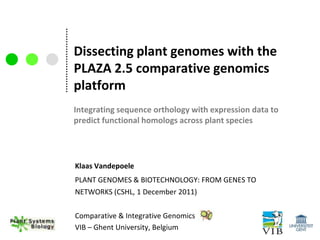
Dissecting plant genomes with the PLAZA 2.5 comparative genomics platform
- 1. Dissecting plant genomes with the PLAZA 2.5 comparative genomics platform Integrating sequence orthology with expression data to predict functional homologs across plant species Klaas Vandepoele PLANT GENOMES & BIOTECHNOLOGY: FROM GENES TO NETWORKS (CSHL, 1 December 2011) Comparative & Integrative Genomics VIB – Ghent University, Belgium
- 2. Genome sequencing in different plant clades 1.0 2.0 2.5 Green algae Chlorophyceae C. reinhardtii V. carteri Prasinophyceae O. lucimarinus Micromomas O. tauri Club-mosses P. patens S. moellondorffii Mosses Monocots O. sativa japonica O. sativa indica S. bicolor Z. mays B. distachon Basal Eudicots V. vinifera L. japonics, M. truncatula, G. max Eudicots Angiosperms P. trichocarpa M. esculenta, R. communis, F. vesca Rosids C. papaya M. domestica, T. cacao A. thaliana A. lyrata Asterids 9 genomes 25 genomes 2
- 3. Exploiting cross-species genome information Centralized infrastructure Detailed gene catalog per species Structural annotation (gene models, UTRs) Functional annotation (experimental, sequence-based) Intuitive & advanced data mining tools for non-expert users • Gene function • Genome organization • Pathway evolution • Data manipulation Computational resources 3
- 4. PLAZA, a resource for plant comparative genomics http://bioinformatics.psb.ugent.be/plaza/ 4
- 5. Gene family analysis Genome analysis 20 tools available! More information? Check Help – Documentation • Data content & Construction • Tutorial & FAQ Proost , Van Bel, … & Vandepoele, Plant Cell 2009 5
- 6. 6
- 7. Comparative sequence analysis Homology = shared ancestral common origin Inferred based on sequence similarity (BLAST) similar (multi-)domain composition & organization So sequence similarity means homology? No, it depends! JGI TAIR All-against-all sequence BLASTCLUST similarity search (BLAST) Tribe-MCL EMBL Inparanoid OrthoMCL C/KOG 7
- 8. Gene family Similarity heatmap, Multiple sequence alignment & Phylogenetic trees >780K proteins from 25 species 18K trees incl. 420K 22K multi-species gene families annotated tree nodes covering 83% of the total proteome 8
- 9. Gene family analysis Genome analysis 9
- 10. Gene colinearity & genome organization Chromosome 1 • Represent chromosomes as sorted gene lists Chromosome 2 • Identify all homologous gene pairs between chromosomes (all- against-all BLASTP). • Score pairs of homologues in matrix 1 Gene Homology Matrix (GHM) i-ADHoRe 3.0 2 10 Proost , Fostier, … & Vandepoele, NAR in press
- 11. Genome-wide colinearity (WGDotplot) Z. mays O. sativa 11
- 13. Multi-species WGDotplots - applet 13
- 14. Whole-genome Circular Dotplot Reference: O. sativa Inner circle: duplicated regions 14 Outer circle: inter-species colinear regions
- 15. Synteny Plot: local genome organization 15
- 16. Gene family analysis Genome analysis 16
- 17. Workbench data import Create a custom gene set (~experiment) using gene identifiers or BLAST External/internal gene IDs (e.g. AN3, AT5G28640, GRMZM2G180246_T01) BLAST interface can be used to map sequence data from a non-model species to a reference species present in PLAZA A toolbox is available to analyze user-defined gene sets Microarray transcript profiling WGMapping Gene Families EST Functional PLAZA GO enrichment sequencing annotations Workbench Sequence Tandem/block retrieval duplicates Genes reported in Suppl. data Orthologs Export data… 17
- 18. GO enrichment analysis for all 25 species! 18
- 19. Detection of orthologous plant genes Meaning… Orthology = genes derived from a common ancestor in different species Functionally conserved homologs = genes in different species having similar functions Due to gene duplication events , complex many-to-many gene orthology is frequently observed Functional homologs in different species share … similar expression? regulation? 19 protein-protein interactions?
- 20. Orthologous genes – Table view 20
- 21. Integrative Orthology Viewer - an ensemble of different gene orthology prediction approaches •Tree-based orthologs (TROG) inferred using tree reconciliation •Orthologous gene families (ORTHO) inferred using OrthoMCL •Anchor points refer to gene-based colinearity between species 21 •Best hit families (BHIF) inferred from Blast hits including inparalogs
- 22. How to evaluate sequence-based orthology methods? Cross-species analysis of orthologs using Expression Context Conservation (ECC) Expression context conservation quantifies shared orthologs in coexpression networks ECC score = 0.088 (16 shared orthologs / 182 in both coexpression clusters) P-value(conserved)<0.001 22 Movahedi, Van de Peer & Vandepoele, Plant Physiology 2011
- 23. Orthology support & expression conservation for Arabidopsis – rice orthologs OrthoMCL (60% ECC global) BHIF (58% ECC global) 3888 2880 4196 5561 8364 60 % 6699 44% 41% 8869 2338 9411 68 % 3875 3022 4281 57% 41% 5886 16367 Legend 41% # Ath genes # Ath – Osa gene pairs TROG (54% ECC global) % Expression conservation (ECC) >3506 Arabidopsis – rice orthologs missed by OrthoMCL show 23 expression conservation (41% ECC)
- 24. Conclusions PLAZA 2.5 provides a versatile toolbox for plant genomics Expression Context Conservation provides a valuable approach to study orthologs and predict functional homologs across species The integration of complementary data types extends the scope of complex orthology relationships 24
- 25. Acknowledgments • – plant comparative genomics Michiel Van Bel Sebastian Proost Yves Van de Peer http://bioinformatics.psb.ugent.be/plaza/ Evolutionary analysis of expression networks Sara Movahedi Plant Physiology 2011 paper 25
Editor's Notes
- 23 plant genomes: 11 dicots, 5 monocotspico-PLAZA: 10 green algae
- Intuitive & complete view of gene orthology
- Method to quantify expression conservation across species by comparing coexpression networks of orthologous genes.These quantifications are robust with respect to moderate modifications in the underlying expression data set, and the method corrects for network connectivity or tissue specific expression when determining significance levels.
- How many genes included?
